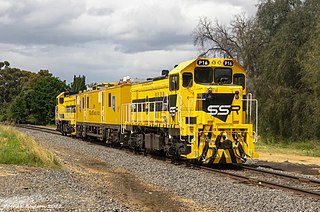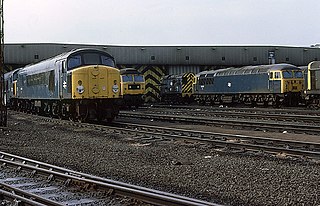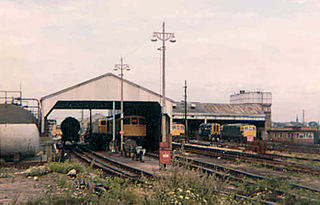
Great North Eastern Railway, often referred to as GNER, was a train operating company in the United Kingdom, owned by Sea Containers, that operated the InterCity East Coast franchise on the East Coast Main Line between London, Yorkshire, North East England and Scotland from April 1996 until December 2007.

Freightliner Group is a rail freight and logistics company headquartered in the United Kingdom. It is owned by Brookfield, a Canadian investment management company and GIC, a Singaporean sovereign wealth fund.

The Class 66 is a type of six-axle diesel-electric freight locomotive developed in part from the Class 59, for use on UK railways. Since its introduction the class has been successful and has been sold to British and other European railway companies. In Continental Europe it is marketed as the EMD Class 66 (JT42CWR).

The Weardale Railway is an independently owned British single-track branch line heritage railway between Bishop Auckland, Witton-le-Wear, Wolsingham, Frosterley and Stanhope. Weardale Railway began services on 23 May 2010, but decided to run special trains rather than a scheduled service for the 2013 season. The line was purchased by the Auckland Project in 2020 with a view to restarting passenger services. In 2021, a bid was submitted to the Restoring Your Railway fund. In October 2021, the Department for Transport allocated funding for the development of a business case.

The Axholme Joint Railway was a committee created as a joint enterprise between the Lancashire and Yorkshire Railway (L&Y) and the North Eastern Railway (NER) and was established by the North Eastern Railway Act 1902 of 31 July 1902. It took over the Goole and Marshland Railway, running from Marshland Junction near Goole to Reedness Junction and Fockerby, and the Isle of Axholme Light Railway, running from Reedness Junction to Haxey Junction. Construction of the Goole and Marshland Railway had begun in 1898, and by the time of the takeover in early 1903, was virtually complete. The Isle of Axholme Light Railway was started in 1899, but only the section from Reedness Junction to Crowle was complete at the takeover. The northern section opened on 10 August 1903, and the line from Crowle to Haxey Junction opened for passengers on 2 January 1905.

Locomotion, previously known as Locomotion the National Railway Museum at Shildon, is a railway museum in Shildon, County Durham, England. The museum was renamed in 2017 when it became part of the Science Museum Group.

The British Rail Class 56 is a type of diesel locomotive designed for heavy freight work. It is a Type 5 locomotive, with a Ruston-Paxman power unit developing 3,250 bhp, and has a Co-Co wheel arrangement. Enthusiasts nicknamed them "Gridirons", due to the grid-like horn cover on the locomotive's cab ends fitted to nos. 56056 onwards. Under its Romanian railway factory nomenclature, the locomotive was named Electroputere LDE 3500, with LDE coming from Locomotivă Diesel-Electrică and the 3500 being the planned horsepower output.

Harwich International railway station is a railway station on the Mayflower Line, a branch of the Great Eastern Main Line, the station serves Harwich International Port in Essex, England. It is 68 miles 72 chains (110.88 km) from London Liverpool Street, between Wrabness to the west and Dovercourt to the east. Its three-letter station code, HPQ, derives from its original name, Harwich Parkeston Quay.

A merry-go-round train, often abbreviated to MGR, is a block train of hopper wagons which both loads and unloads its cargo while moving. In the United Kingdom, they are most commonly coal trains delivering to power stations. These trains were introduced in the 1960s, and were one of the few innovations of the Beeching cuts, along with investment from the Central Electricity Generating Board (CEGB) and the NCB into new power stations and loading facilities.

Southern Shorthaul Railroad is an Australian rail freight services operator in New South Wales and Victoria. The company also provides workshop services, such as rolling stock manufacturing and wagon and locomotive maintenance.

Laira Traction and Rolling Stock Maintenance Depot is a railway traction maintenance depot situated in Plymouth, Devon, England. The depot is operated by Great Western Railway (GWR) and is where their fleet of Class 802 InterCity Express Trains and remaining Castle Class trains are overhauled. Other trains visit for daily servicing including some operated by CrossCountry.

Gateshead TMD was a railway traction maintenance depot situated in Gateshead, England. The depot code was 52A during the steam era and GD later on.

Toton Traction Maintenance Depot or Toton Sidings is a large traction maintenance depot located in Toton, Nottinghamshire. The TOPS depot code for the depot is TO. Before TOPS, the shed code was 16A.

Hither Green (London) Traction Maintenance Depot or Hither Green (London) TMD is a railway depot used for the maintenance and servicing of freight trains adjacent to the Hither Green marshalling yard. The depot is a hub for moving freight around south-east England; it is owned and operated by DBS. The official depot code is HG; in steam days, the shed code was 73C.

Wath marshalling yard, also known as Wath concentration yard, was a large railway marshalling yard specifically designed for the concentration of coal traffic. It was set at the heart of the South Yorkshire Coalfield, at Wath-upon-Dearne, approximately halfway between Barnsley and Doncaster, in the United Kingdom. It opened in 1907 and closed in 1988.

El Zorro was an Australian railway operator hauling freight and infrastructure trains in Victoria and New South Wales.
The Great Northern and Great Eastern Joint Railway, colloquially referred to as "the Joint Line" was a railway line connecting Doncaster and Lincoln with March and Huntingdon in the eastern counties of England. It was owned jointly by the Great Northern Railway (GNR) and the Great Eastern Railway (GER). It was formed by transferring certain route sections from the parent companies, and by the construction of a new route between Spalding and Lincoln, and a number of short spurs and connections. It was controlled by a Joint Committee, and the owning companies operated their own trains with their own rolling stock. The Joint Line amounted to nearly 123 miles (198 km) of route.

Hanson Traction Ltd was a locomotive leasing company based at Washwood Heath, Birmingham, West Midlands.

Doncaster Carr rail depot is a railway vehicle maintenance depot located alongside the East Coast Main Line in Doncaster, England. It is presently operated by Hitachi as part of their contract to maintain the AT300 units for London North Eastern Railway and TransPennine Express.

Intermodal railfreight in Great Britain is a way of transporting containers between ports, inland ports and terminals in England, Scotland and Wales, by using rail to do so. Initially started by British Rail in the 1960s, the use of containers that could be swapped between different modes of transport goes back to the days of the London, Midland & Scottish Railway.






















